The iPhone 4 Redux: Analyzing Apple's iOS 4.0.1 Signal Fix & Antenna Issue
by Brian Klug & Anand Lal Shimpi on July 15, 2010 12:28 PM EST- Posted in
- Smartphones
- Apple
- iOS 4
- iPhone 4
- Mobile
Better at the Low End, Mixed Feelings Everywhere Else
Brian came up with the plan to enable the numerical signal strength visualization and executed on it very well in our original iPhone 4 review. Since then there’s been a disturbing amount of debate as to whether or not this actually amounts to a problem with the phone.
Part of the confusion stems from the fact that doing this sort of antenna testing in a real world scenario is time intensive. As Brian mentioned on the previous page, for today’s article both of us were driving around our respective cities, stopping at various locations, measuring signal strength and comparing it to bar mappings in order to produce the charts you saw on the other page.
There’s no denying that Apple has played a significant role in why there continues to be debate about the iPhone 4 antenna. By simply addressing the pre-4.0.1 bars not being a good representation of signal strength and ignoring the fact that the iPhone 4 does lose more signal strength than competing phones depending on how you hold it, Apple manages to convince its faithful that there’s nothing wrong while driving its critics to demand a recall.
My mother always taught me that honesty is the best policy and presumably I’m not the only one in the world who was privy to this information. Had Apple come clean with both of these facts (the bar mapping and the signal attenuation issue) early on we’d be in a far more clear cut world today.
We have consistently argued that the 4’s antenna is a design choice by Apple. As we’ve seen in our testing there are situations where the iPhone 4’s antenna makes things better (e.g. holding onto calls with very low signal strength) and other situations where the design makes them worse (e.g. holding it wrong in situations with low signal strength). I wanted to describe the inconsistency in greater detail so I went out with an iPhone 3GS and 4 and documented my experiences.
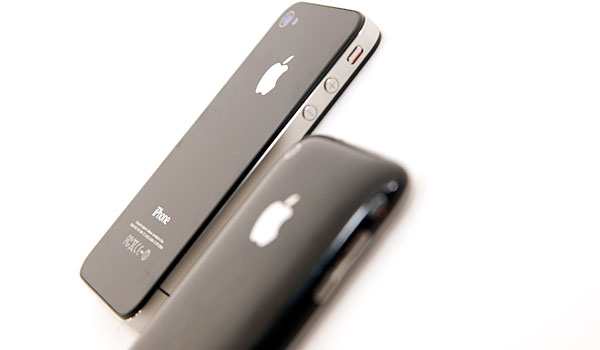
In practice I found three things that were true about the iPhone 4’s antenna behavior compared to the 3GS.
Reception in average conditions is sometimes significantly better on the iPhone 4 than on the 3GS. Take a look at the image capture below. In the same exact location we have better reception on the 4 than the 3GS. Granted this could be due to a number of variables outside of the phone’s antenna itself, but it happened enough times that it’s worth reporting. This is the positive to Apple’s external antenna design - you can and do get better reception. Unfortunately the tradeoff is the scenario I just described before this.
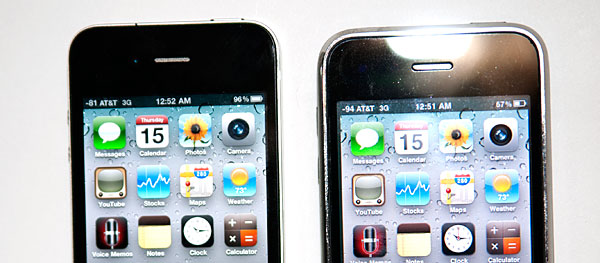
iPhone 4 (left) at -81 dBm vs. iPhone 3GS (right) at -94 dBm
Signal strength is sometimes the same as or worse than the iPhone 3GS. This is really where the problem comes into play. In the shot below I have the 4 and 3GS sitting next to one another and they are displaying roughly the same signal strength. We’ve already proven that holding the iPhone 4 attenuates its signal more than the 3GS, which results in the frustration we’ve seen expressed by many at this point. In situations where the 4 has the same signal as the 3GS, holding the phone is going to drop it to levels significantly worse than the 3GS. If you’re in an area with low signal strength to begin with, holding the phone is going to bring you down to dangerously low levels.
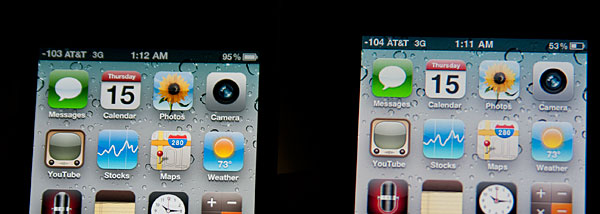
iPhone 4 (left) at -103 dBm vs. iPhone 3GS (right) at -104 dBm
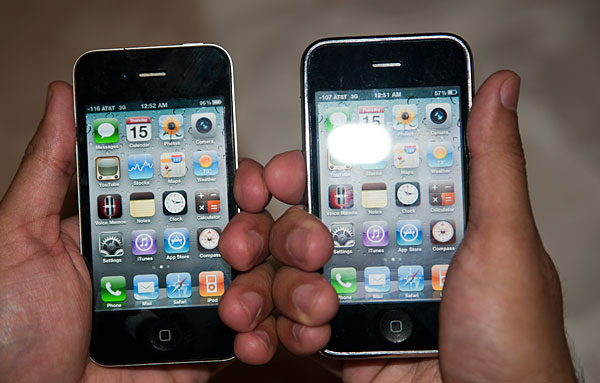
iPhone 4 being held tightly (left) at -115 dBm vs. iPhone 3GS being held tightly (right) at -107 dBm
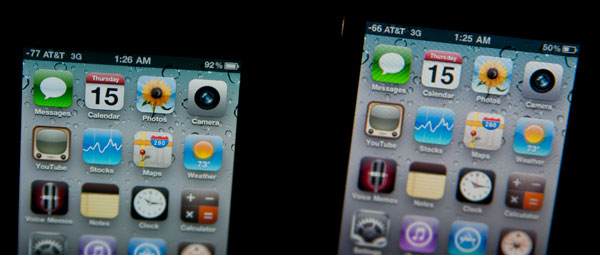
iPhone 4 (left) at -77 dBm vs. iPhone 3GS (right) at -66 dBm
The iPhone 4 is better at holding onto calls and data at very low signal levels. We’ve mentioned this one before but it’s worth reiterating. The new antenna does let me make calls and transmit data at very low signal strength. With the iOS 4.0.1 update I was able to make a call at -115dB on the 3GS, however the call did drop within a minute of starting it. By comparison I was able to have a much longer conversation without dropping the call at -120dB on the 4. By no means is this a scientific comparison, but anecdotally both Brian and I feel that the low signal strength performance of the iPhone 4 is better than the 3GS.

A call at -120 dBm on the iPhone 4
If you’re keeping tabs you’ll note that this is what is traditionally referred to as a trade off. Apple opted for good performance in low signal situations (and style of course) over maintaining consistently better or unchanged radio performance compared to the 3GS. I would personally consider this to be an unnecessarily risky design choice, particularly for a smartphone vendor. Note that it's nearly impossible to separate out the antenna from the rest of the iPhone 4 platform to determine exactly what is responsible for the phone's signal sensitivity in various situations. All we ultimately know is how physically interacting with the antenna impacts reported signal strength.
I can’t stress enough that this issue impacts all users. The variability is in how strong of a signal you have to begin with. That’s the absolute only reason there’s debate in these discussions from phone to phone. At my desk I don’t get great reception on AT&T. With the iPhone 4 I’m usually at -96dBm. If I keep a tight grip on the phone or if I’m holding it to send text messages I can sometimes lose all signal entirely. This is a combination of poor reception at my house and the fact that the 4 loses more of its signal than other phones when held certain ways.
Brian on the other hand has much better reception at his home. To him, the signal strength drops but it does not drop enough for this to be a problem. I consider myself to be on the border. If I’m mindful of how I’m holding the phone it’s not an issue, and even most of the time if I’m not paying attention to it it’s not an issue. However there are definitely times when it does become a problem. I wouldn’t consider it to be the majority of the time or even more than 10% of the time, but it happens enough for me to have to think about it. Ultimately this is why I consider Apple’s design here to be unnecessarily risky. Introducing a change with stylistic and technical benefits where the downside is limited but potentially very noticeable is just ballsy.
Luckily for Apple, there are things that can be done about it.










146 Comments
View All Comments
takkischitt - Thursday, July 22, 2010 - link
Hi,I've been looking everywhere to try and source the correct Kapton tape but I'm struggling.
Can anyone give me an extact model number and description so I can hopefully find the right one to order on the net?
Thanks!
Great article btw
crashnburn - Saturday, July 24, 2010 - link
Question is.. Am I better off with getting an iPhone 4 or a 3GSv12v12 - Sunday, July 25, 2010 - link
Wow this is hilarious... people are using tape and all kinds of MacGyver tricks and tinkering to get it to work "properly" or "better." WHO DOES THIS? Would any of you accept a washing machine that required a rubber stopper from home depot to properly seal in water? Or would you use some aluminum foil to increase your brand new flat screen's picture (hypothetically speaking of course)???RETURN the fscking thing, roll the dice and get another one, OR get a Droid or some other phone thats known to work?
The stupid masses have gotten HAD again... "OMG I've GOT to get the newest, (BETA) latest, greatest phone so I can be cool and waste hours of daily productivity playing around with it like a toy like everyone else..." Baaaaah baaaaaaah, said the sheeple. WAKE UP noobs, YOU DO NOT BUY NEW PHONES, until they've been thoroughly tested and de-bugged. Christ, anyone that knows anything about technology knows TODAYS devices are public-BETAs that the corps use YOU to test, while they profit from your fully-paid dollars up front, which they immediately invest in hedge funds and the stock market to recoop massive short-sell interest from, while YOU all are not only footing the bill for, BUT doing all the leg-work by testing the phones and reporting (complaining) back to them... I digress.
YOU all are the problem, there's NEVER been a "beta-test" type market like this crap we have today, bc YOU all have ALLOWED this POS beta-warez business model to flourish and take advantage OF US ALL... This is just a waste of txt, since you'll just keep buying and shopping to be "cool," and "hip."
Thanks a lot sheep... See you at the slaughter house! Please... AFTER YOU... I insist ;-)
kalleboo - Tuesday, July 27, 2010 - link
The android bars vary by manufacturer, they're not all exactly the same. My Sony Ericsson X10 shows 3 bars for -85 dBm/14 asu, contrary to this graphbubblesmoney - Wednesday, July 28, 2010 - link
On GSM or UMTS frequencies (between 870 MHz to 2170MHz around the world) used the noise signal floor is between -111 to -114dbm. The signal noise floor is that strength at which the signal cannot be distinguished from background radiation.The signal noise floor depends on the frequency of broadcast and not the device as far as i am aware. So the iphone cannot have a different noise floor compared to other mobile phones, unless Jobs got the governments all over the world to beam a special signal on a different frequency purely for the iphones!!!!
Anandtech has made a basic error in this analysis i think and consequently this whole article is wrong and meant to favour the iphone either inadvertantly or deliberately.
see post number 57 on the thread in this link for my explanation why this anandtech article is wrong http://forums.moneysavingexpert.com/showthread.php...
please note that -113dbm (some resources say -111 instead of -113) is the noise floor where signal is indistinguishible from background radiation. look it up in science webpages if you doubt what i say. so if the iphone shows signal to be -120dbm then that is an error. just because it shows a number does not mean that the -113 noise floor value does not exist in physics for gsm broadcast frequencies. http://en.wikipedia.org/wiki/Johnson%E2%80%93Nyqui...
see gsm freq bands for the world here http://en.wikipedia.org/wiki/GSM_frequency_bands the freq bands (GSM AND UMTS) used in uk are between 870 to 2170MHz and for that the noise floor is between -111dbm and -113dbm and for the noise floor to be 120dbm the freq would have to be in 180kilohertz which is !!!! and bull as the freq bands used are in MHz so the anandtech numbers dont add up in the 120dbm small print, as there is no 180kilohtz band for gsm in usa or uk as far as i can tell!!!! and 180khz is the freq used for AM band radio and looks like the iphone4 is getting interference from 180khz AM band radio signals too as far i can tell from what anandtech says about 120dbm etc !!! yikes!
I would be happy to be proved wrong and to learn, but from what i have shown i am right! Noise floor depends on the frequency band of transmission rather than circuitry. In the UK Cellular mobile services operate within the frequency ranges 872-960 MHz, 1710-1875 MHz and 1920 - 2170 MHz so the noise floor would be between -114 to -111dbm.
It would be similar in the USA too.
see the rest of my detailed response elsewhere on other forums (post 57 of the thread on the link) http://forums.moneysavingexpert.com/showthread.php...
I hope there is a response to this comment of mine, from this articles writers or some other RF engineers, as due to the reasons quoted in my ananlysis i think this article by anandtech is grossly wrong. I would be happy to stand corrected if my analysis is wrong.
yes the signals can be sensed at -120dbm but that wouldnt be signals from commercial GSM or UMTS signals, it would be some other signals sensed by the iphone4 sensors and giving a wrong reading of the signal strength. As i said earlier the signal noise floor depends on the broadcast frequency and not the handset, so this article is wrong and grossly so as it is making assumptions of the iphone4 being able to sense GSM / UMTS signals of the order of 120dbm which isnt possible for the frequencies broadcast as per the physics involved. http://en.wikipedia.org/wiki/Johnson%E2%80%93Nyqui... that or Jobs and anandtech found some way to defy physics!
amariofrmdamoon - Sunday, November 4, 2012 - link
I've never seen kapton tape used that way, but a good source for it seems to be www.kaptontape.com. There are some other insulating tapes at www.maskingproducts.net. May be worth a try to see if some other cheaper tapes work in a similar manner. Anyone know if it works similarly with the iphone 5. Thanks!